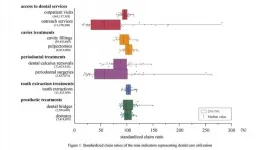INFORMATION:
The publication with 20 international co-authors was a result of subproject A3 of the Collaborative Research Centre (CRC) 806 'Our Way to Europe' at the University of Cologne, which was granted in 2009 and cooperates closely with the UoC's Institute for Prehistory and Early History as well as the Universities of Bonn and Aachen. The aim of the CRC is to understand the reasons for the migration history of our ancestors (Homo sapiens) from Africa to Europe. The Chew Bahir Deep Drilling Project is associated with the international 'Hominin Site and Paleolakes Drilling Project' (HSPDP).
Climate conditions during the migration of Homo sapiens out of Africa reconstructed
2021-06-14
(Press-News.org) An international research team led by Professor Dr Frank Schäbitz has published a climate reconstruction of the last 200,000 years for Ethiopia. This means that high-resolution data are now available for the period when early Homo sapiens, our ancestors, made their way from Africa to Europe and Asia. Schäbitz and his colleagues determined the dates using a drill core of lake sediments deposited in southern Ethiopia's Chew Bahir Basin, which lies near human fossil sites. Temporal resolution of the samples, reaching nearly 10 years, revealed that from 200,000 to 125,000 years before our time, the climate there was relatively wet, providing enough water and thus abundant plant and animal food resources in the lowlands of East Africa. From 125,000 to 60,000 years ago, it gradually became drier, and particularly dry between 60,000 to 14,000 years ago. The data now obtained fit well with genetic findings, according to which our direct genetic ancestors ('African Eve') left Africa 'successfully' during a wet phase about 70,000 to 50,000 years ago.
The article 'Hydroclimate changes in eastern Africa over the past 200,000 years may have influenced early human dispersal' has appeared in Nature Communications.
Scientists collect information about the environment from lake sediments because, in the best case, sediments are flushed into lakes relatively continuously from the catchment through erosion. In addition to mineral components, sediments include organic material and remains of organisms living in the lake. If lake sediments from suitable lakes can be drilled, these 'proxy data' can be used to draw conclusions about environmental conditions at the time, and thus help to reconstruct the climate.
From November to December 2014, the researchers recovered an approximately 300 metre long drill core from the Chew Bahir Basin in southern Ethiopia, which dries out during the dry season. In its entirety, the drill core dates back to about 620,000 years. 'This enables us to chronologically cover the entire evolutionary history of Homo sapiens in Africa. The work now published on the last 200,000 years of this drill core thus provides very good evidence of the environmental and climate history during the migration of our ancestors,' Schäbitz explained.
'Some of our proxies allow time resolution for specific decades in large sections of the core, which has not been done before for this part of Africa. That way we can capture very short-term climate changes representing less than a human lifetime,' he said. The drill core reveals that the climate of East Africa was largely influenced by changes in solar insolation, which led to either wet or dry climate conditions. From 200,000 to 125,000 years ago, the climate was generally relatively favourable, i.e., the lowlands provided enough water and thus abundant plant and animal food resources for our ancestors. Under such conditions, people could move relatively easily over long distances and even reach the Arabian Peninsula, as evidenced by the oldest fossil finds there (about 175,000 years ago). From 125,000 to 60,000 years ago, however, it gradually became drier, and then particularly dry between 60,000 to 14,000 years ago, with the lake drying up completely several times.
'However, during this period in particular, quite striking, short-term moisture fluctuations can also be observed, the temporal patterns of which are reminiscent of cold-warm climate fluctuations known from Greenland ice cores. So the people who lived in East Africa at that time were exposed to extreme changes in their environments,' Schäbitz said. 'It is interesting that just in the period from 60,000 to 14,000 years ago, when the lowlands of East Africa were repeatedly particularly dry, numerous archaeological findings in the high altitudes of the Ethiopian mountains bear witness to the presence of our ancestors there.' In addition, the weapons and tools of these people also evolved during this time period (transition from Middle to Late Paleolithic in Africa). 'We suspect that the greater "environmental stress" at lower elevations forced this development,' the scientist noted.
Furthermore, the scientists noted that the last major wet phase which we can see in the core fits well in time with the genetic findings: It shows that our direct genetic ancestors 'successfully' left Africa about 70,000 to 50,000 years ago. Their descendants probably reached southeastern Europe 50,000 to 40,000 years ago, where they encountered Neanderthals.
'We hypothesize that the evidence of dry-humid climate fluctuations in East Africa found in our drill core had a significant impact on the evolution and mobility of our ancestors,' said Schäbitz. 'Migration out of Africa was possible several times during the last 200,000 years, during periods when the climate was wetter, and has led to the spread of our ancestors as far as Europe. During the particularly dry phases of the recent past, starting around 60,000 years ago, Homo sapiens groups repeatedly managed to survive in the high altitudes of mountainous Ethiopia.'
ELSE PRESS RELEASES FROM THIS DATE:
The evolution of good taste
2021-06-14
Does evolution explain why we can't resist a salty chip? Researchers at NC State University found that differences between the elemental composition of foods and the elemental needs of animals can explain the development of pleasing tastes like salty, umami and sweet.
Taste tells us a lot about foods before they are swallowed and digested, and some tastes correspond with the elemental composition of foods. For example, an aged steak lights up the umami taste receptors, because it has a high concentration of the element nitrogen, which occurs in amino acid molecules. Nitrogen is essential for survival, but often occurs in low concentrations relative ...
Study finds survival is more important than a chronic medical condition in prioritizing medical care
2021-06-14
(Boston)-- The concept of rationing medical resources during the height of COVID-19 pandemic created tremendous anxiety in the patient and healthcare communities. In planning for that possibility Massachusetts created a triage scoring system focusing on an acute survival score that considers chronic life-limiting medical conditions of the patient, but it does not provide specifics about how to value those conditions in the equation.
Now a new study supports prioritizing resources to those who are most likely to survive an acute illness as several chronic medical conditions had less of an impact on longer-term survival than previously suspected.
"No one ...
Study reveals factors that shape Haitian Creole-speaking women's birth plans after C-sections
2021-06-14
(Boston)--Despite evidence regarding the benefits of vaginal birth after cesarean and recommendations to support shared decision making to reduce cesarean rates, minority women face many impediments that limit their access to appropriate health information and opportunities for such discussions.
Haitian women in Massachusetts have the highest rates of cesarean section and low rates of vaginal birth after cesarean, despite evidence suggesting that many are eligible to attempt vaginal birth after a previous cesarean.
Now a new study explores how Haitian women's beliefs, values and attitudes influence their decision making about pregnancy and birth after having had a cesarean delivery. In conjunction with the providers' views about Haitian women, the information ...
Breeding foxes for opposite behaviors produces similar brain changes
2021-06-14
Farmed foxes selectively bred for tameness and aggressiveness exhibit similar changes to their brain anatomy, according to research recently published in JNeurosci. Both lineages also have larger brains than conventional farm-bred foxes, complicating leading theories on domestication.
Domesticated species provide insight into complex evolutionary processes on a condensed timeframe. When a species splits from its wild counterpart, its brain, body, and behavior undergo rapid changes. Studies with chickens, sheep, cats, dogs, and more indicate domestication shrinks the brain. But the same pattern does not extend to foxes in the expected way.
Hecht et al. used MRI to measure the brain size ...
Domesticated foxes display increased size in brain regions
2021-06-14
When Erin Hecht was earning her Ph.D. in neuroscience more than a decade ago, she watched a nature special on the Russian farm-fox experiment, one of the best-known studies on animal domestication.
The study, running since 1958, tries to replicate the natural domestication of wolves to dogs by selectively breeding two strains of silver foxes so they exhibit certain behaviors. Scientists breed one to be tame and display dog-like behaviors with people, such as licking and tail wagging. The other is bred to react with defensive aggression when faced with human contact, while a third strain acts as the control and isn't bred for any specific behaviors.
Hecht, who's now an assistant professor in the Harvard Department of Human ...
A step closer to a hydrogen-fuelled economy using an efficient anode for water splitting
2021-06-14
Niigata, Japan - In the recent past, there has been a paradigm shift towards renewable sources of energy in order to address the concerns pertaining to environmental degradation and dwindling fossil fuels. A variety of alternative green energy sources such as solar, wind, hydrothermal, tidal etc., have been gaining attention to reduce the global carbon footprints. One of the key challenges with these energy generation technologies is that they are intermittent and are not continuously available.
"We cannot use solar energy at night and wind energy when the wind is not blowing. But we can store the generated electricity in some other forms and utilize it whenever required. That is how water splitting bridges the gap and has emerged as a very promising energy storage ...
Gaps to fill: Income, education may impact inequalities in seeking dental care
2021-06-14
Tsukuba, Japan - Inequitable access to health care is a pressing global health concern, and care of our teeth is no exception. In fact, the World Health Organization established the Global Goals for Oral Health 2020 in its efforts to help counter socioeconomic-related imbalances. Economically advanced Japan has plentiful dentists, as well as a universal health insurance system, yet it also has oral care-related inequities, according to a new study.
A team of researchers centered at University of Tsukuba in Japan examined a huge set of claims and checkup data in search of regional and socioeconomic trends. Their findings included the key observation that regional lower ...
New research shine light on perovskite solar cell performance
2021-06-14
The potential of a class of materials called perovskites to enable solar cells to better absorb sunlight for energy production is widely known. However, this potential has yet to be fully realised, particularly under real-world operating conditions.
New research published today in the prestigious journal Nature Energy, has revealed defects in a popular perovskite light absorber that impede solar cell performance. The researchers found a change in the nature and density of these 'intragrain planar defects' correlated with a change in solar cell performance.
The discovery by an international team of researchers, led by Monash ...
Trees, plants and soil could help cities cut their carbon footprints -- when used smartly
2021-06-14
Cities and nations around the globe are shooting for carbon neutrality, with some experts already talking about the need to ultimately reach carbon negativity. Carbon footprint declarations are used in construction to ease product selection for low carbon building, but these standards don't yet exist for green elements like soil, bushes and plants. A new study led by Aalto University is the first to map out how green infrastructure can be a resource for cities on the path to carbon neutrality.
The study, done in collaboration with the Natural Resources Institute Finland (Luke) and the University of Helsinki, charted out the lifecycle phases of plants, soils and mulches to determine the basic considerations needed to create standards for products commonly used in green ...
Malaysia registers first hepatitis C treatment developed through South-South cooperation
2021-06-14
The National Pharmaceutical Regulatory Agency (NPRA) of Malaysia has granted a conditional registration for a safe, effective hepatitis C treatment developed by a public-private partnership bringing together the Malaysian Ministry of Health, not-for-profit research and development organization Drugs for Neglected Diseases initiative (DNDi), Egyptian pharmaceutical company Pharco, Malaysian pharmaceutical company Pharmaniaga Berhad, and non-governmental-organization Médecins Sans Frontières/Doctors Without Borders (MSF).
This is the very first drug for hepatitis C virus (HCV) to be developed through South-South collaboration and with funding and clinical support from non-profit organizations.
This partnership ...



